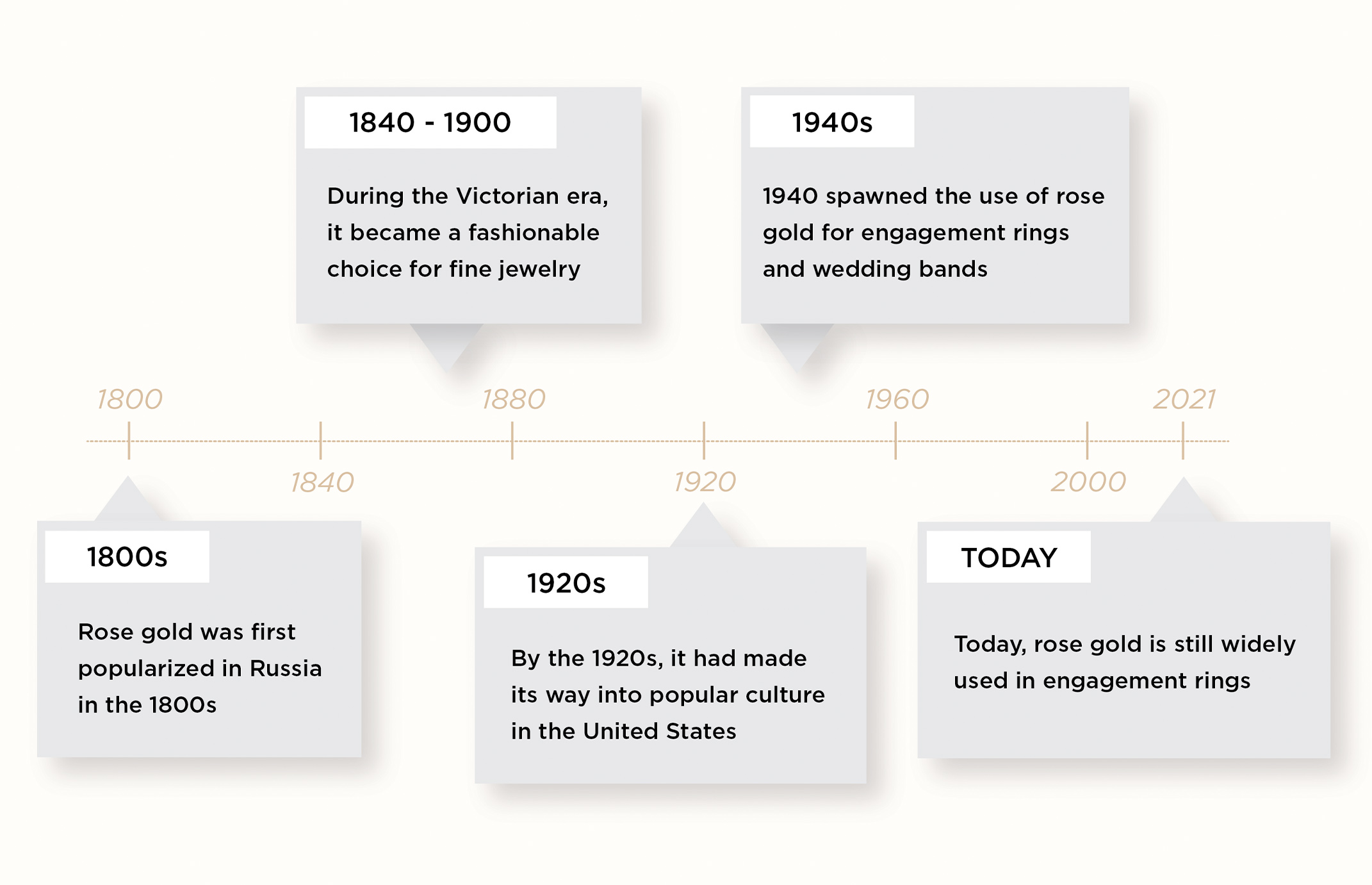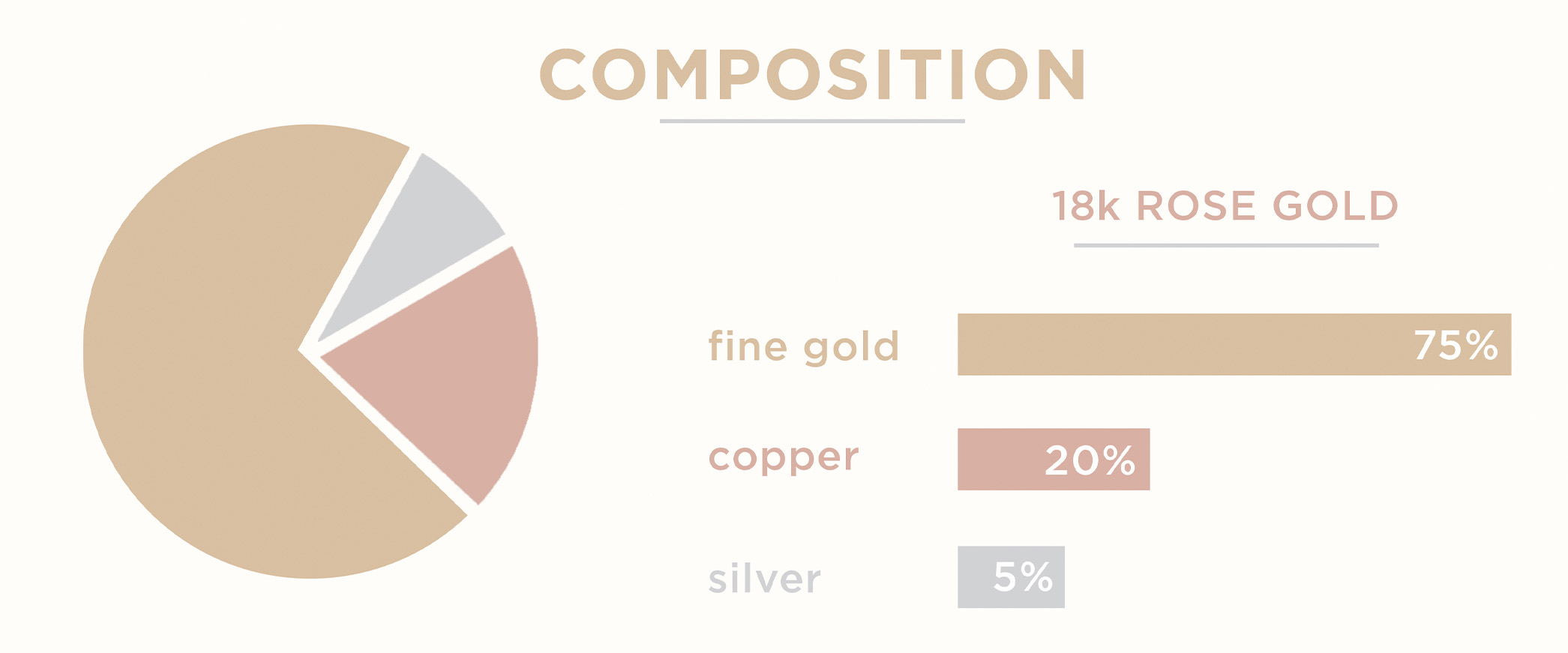How Is Rose Gold Made: A Timeless Tale of Blush Royalty
January 9th, 2024 / Alese Oldenburg
Rose gold has become a popular choice for both engagement rings and all jewelry. Its feminine look, refined nature, and unique color appeal to a variety of tastes and styles. Plus, it looks beautiful with diamonds and precious gemstones, making rose gold engagement rings well sought after. While rose gold is its common name, it is also referred to as pink gold or red gold because of its various hues. So how does it get its coveted rosy color and how is rose gold made? Here, we’ll discuss how rose gold is made, its rose gold composition, and the uniqueness that makes it so desirable.
Without further ado, let us introduce you to the pink metal of the family…

The History of Rose Gold
Rose gold was first popularized in Russia in the 1800s, which is why it is sometimes referred to as “Russian gold.” However, it didn’t stay confined to the country for long. During the Victorian era, it became a fashionable choice for fine jewelry, and by the 1920s, it had made its way into popular culture in the United States. At this time, it was famously used in Cartier’s eye-catching “Trinity Ring” alongside white gold and yellow gold—a mix that is still quite popular today. Despite the famed Trinity Ring, rose gold fell from popularity after the 20s until the 1940s when the top metal choice for engagement rings, platinum, was needed for war efforts. This spawned the use of rose gold for engagement rings and wedding bands.
Today, rose gold is still widely used in engagement rings, and for good reason. Its rosy sheen is romantic and pairs beautifully with bright white diamonds and other popular stones such as morganite too. Its popularity as a metal has spawned rose gold in everything from makeup to laptops to hair color.
Since its beginning, the desire for rose gold jewelry has swelled and waned. And while some may think it’s a trendy choice for modern brides, its history also appeals greatly to the vintage heart.

What Is Rose Gold Made Of?
Unlike gold, rose gold is not a pure substance occurring in nature. Like other gold materials used in jewelry, rose gold is made up of a combination of gold alloys and other metal alloys. Pure gold is far too soft to be made into jewelry, which is why it is paired with other, stronger metals to withstand everyday wear and last forever. The particular metals it is paired with, however, impact its color. In the case of rose gold, the additional metals are chosen for the very reason of impacting its color.
What metals turn yellow gold into rose gold? It is a combination of copper and silver metal alloys, and sometimes zinc. When these alloys are added to pure yellow gold, the result is an irresistible pink hue.
How Is Rose Gold Jewelry Made?
To understand how rose gold is made, you must first understand how all gold for engagement rings and other jewelry is made.
Pure gold is 24 karats. However, as we mentioned above, pure gold is far too soft to be made into durable jewelry. This is why gold jewelry is offered in 14 karat gold and 18 karat gold. There are many similarities and differences when comparing 14K rose gold vs 18K rose gold. While 18K gold may be purer and thus, more valuable, it is also weaker than 14K gold. Similarly, rose gold most commonly comes in 18 karat and 14 karat varieties. The remaining 6 karats or 10 karats, respectively, come from additional metals such as copper, nickel, silver, zinc, or palladium.
Rose gold is made by combining pure gold with copper metal alloys and silver metal alloys. The amount of each metal used will affect the final hue of the rose gold. This is why you may see rose gold that appears lighter than other rose gold, rose gold that appears pinker than other rose gold, and rose gold that appears redder than other rose gold.

What Makes Rose Gold Unique?
Undoubtedly, rose gold stands out as a truly distinctive metal, making a bold statement in the world of jewelry. Unlike its more traditional counterparts like silver and gold, rose gold has only gained widespread popularity in the last two hundred years. However, its recent arrival on the scene isn’t the only factor that contributes to its uniqueness; there are several features that set rose gold apart.
The Color
At the heart of rose gold’s uniqueness is its captivating color. The rosy hue is a harmonious blend of modern aesthetics and vintage charm, making it a standout choice for those seeking something truly special. What sets it apart even more is its relative rarity compared to the more commonly chosen yellow gold and white gold. This scarcity of popularity provides individuals with alternative styles an enticing and distinctive option, allowing them to express their uniqueness through their choice of metal.
The Meaning
Beyond its aesthetic appeal, rose gold carries profound symbolism. While gold, in general, symbolizes elegance and affluence, rose gold takes it a step further. This unique metal is not just about opulence; it signifies style, passion, and refinement. Above all, rose gold is the embodiment of love, making it an exceptionally romantic choice for symbolic jewelry like engagement rings. If you’re seeking depth and sentimentality in the symbolism of your engagement ring, few choices rival the romantic allure of rose gold.
Rose Gold Ages Beautifully
Fresh from the furnace, rose gold has a beautiful color, as we mentioned above, but its beauty only grows over time. The copper tinge that gives it a vintage feel from the beginning continues to contribute to its elegant quality over the course of a lifetime. After a long time, the reddish part in rose gold mixes with the air to make a pretty patina on its surface. This look is only seen in old rose gold and makes it super special. Because of this, rose gold is perfect for making jewelry that’s meant to be passed down in your family.
As rose gold gets older, it changes a bit and tells a story about the person who wears it. Each piece becomes unique and special, and instead of losing its charm, it gains more character over time. This change is what makes rose gold different, and it becomes a symbol not just of looking good, but also of lasting relationships and the time that goes by.

Rose Gold is Easy To Match
If you want to mix rose gold with your other jewelry, it’s easy and looks really good. Rose gold has both gold and silver, so it goes well with yellow gold, white gold, or silver. You can mix it with your everyday jewelry or even use it with other metals for your engagement ring and wedding band. You could put a rose gold engagement ring with a white gold band, or add rose gold bands to a white or yellow gold engagement ring.
Besides going well with other metals, rose gold also looks good on all skin tones. The mix of yellow gold, silver, and copper in rose gold makes it look good on both warm and cool skin tones.
Mixing and matching with rose gold is not just about metals; it’s also about styles. Rose gold works well with both classic and modern looks. Whether you’re dressing casually or for a fancy event, rose gold fits right in, making it a great choice for all kinds of jewelry. Its ability to go along with different styles means that your rose gold pieces will always be in style.
The Durability
People might think that rose gold is not strong, but it’s actually tougher than white gold and yellow gold because it has copper in it. This strength is really important, especially for jewelry you wear every day and for wedding rings that you want to last a long time. Rose gold is not just tough; it doesn’t need much care to keep it looking good. Unlike white gold which needs a special coating every few years, rose gold doesn’t need that. If you know how to clean it and shine it regularly, your rose gold jewelry will always look nice.
Rose gold’s strength is not just about resisting everyday wear; it’s also about staying fashionable even as trends change. Unlike things that go out of style quickly, rose gold always looks good. Its lasting strength, both in staying strong physically and looking nice, makes rose gold a good investment. It doesn’t follow passing trends, ensuring that it stays beautiful and classy for a long time.
The Best Rose Gold Jewelry
Rose gold is extremely versatile, and thanks to its recent popularity it is widely available in an array of styles and jewelry types. Rose gold is a popular choice for everyday jewelry such as dainty necklaces, stud earrings, and stackable rings because rose gold tarnish does not occur if it’s real. Not to mention, this is because its subtle color complements most skin tones, and clothing, and pairs beautifully with other colored jewelry. Whenever you shop for rose gold jewelry, be sure to look for a hallmark that displays a karat weight of 18K or 14K rose gold. Rose gold jewelry without a hallmark is likely rose gold plated, which will fade and tarnish over time.
Shop our selection of 14K rose gold pendants and chains, rose gold earrings, and rose gold bracelets to experience the beautiful variety of everyday rose gold jewelry available.
Beyond everyday jewelry, though, rose gold is a coveted option for an engagement ring as well. Gone are the days when brides could only choose from silver or gold for their diamond engagement ring. This precious metal not only provides another option, but a romantic, fashionable, and non-traditional one that speaks to many future brides and grooms too.
At the end of the day, the color of gold you choose for your engagement ring is completely up to you. Your style and preferences may lead you to choose a rose gold engagement ring. If this unique metal is calling your name, browse our selection of rose gold diamond engagement rings to find a style that suits you best.

*Here at Diamond Nexus, we strive to provide valuable information while being clear and honest about our products. The Nexus Diamond™ alternative is a patented lab created diamond simulate that, among all simulants, most closely imitates the look, weight and wear of a diamond, with two exceptions – it is absolutely perfect in every way, and it costs significantly less. Price points and environmental facts expressed in this blog were taken from popular online retailers and may vary. Learn more about the environmental impact of mining by visiting our blog.

